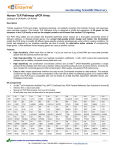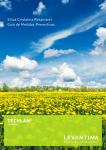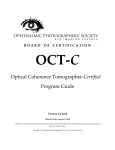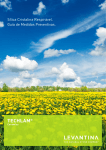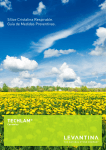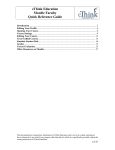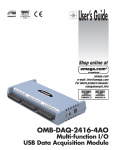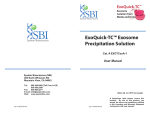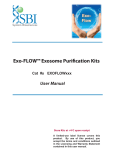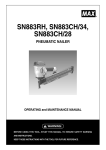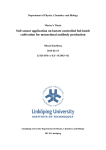Download XPEP Exosome Mass Spec Kit
Transcript
XPEP Exosome Mass Spec Kit Cat# XPEP100A-1 User Manual System Biosciences (SBI) 265 North Whisman Rd. Mountain View, CA 94043 Tel: 888.266.5066 (Toll Free in US) 650.968.2200 Fax: 650.968.2277 E-mail: [email protected] Web: www.systembio.com Store Kits at -20ºC upon receipt A limited-use label license covers this product. By use of this product, you accept the terms and conditions outlined in the Licensing and Warranty Statement contained in this user manual. XPEP™ Exosome Mass Spec Kits Cat. # XPEP100A-1 Contents I. Introduction ..............................................................................1 A. Exosome Overview .................................................................1 B. The XPEP kits for exosome proteomic analysis .....................2 C. XPEP Procedures ...................................................................2 D. Sample XPEP exosome data .................................................8 E. Related Products and Services ............................................14 F. Additional Materials Required ...............................................17 G. Shipping and Storage Conditions for Kits .............................17 I. II. References ............................................................................18 III. Technical Support ..............................................................19 VII. Licensing and Warranty information ..................................19 Introduction A. Exosome Overview Exosomes are 60 - 180 nm membrane vesicles secreted by most cell types in vivo and in vitro. These microvesicles are produced by the inward budding of multivesicular bodies (MVBs) and are released from the cell into the microenvironment following the fusion of MVBs with the plasma membrane. Exosomes are extracellular, nanoshuttle organelles that facilitate communication between cells and organs. Exosomes are found in blood, urine, amniotic fluid, breast milk, malignant ascites fluids and contain distinct subsets of RNAs and proteins depending upon the cell type from which they are secreted, making them useful for biomarker discovery. SBI has engineered tools and provides 888-266-5066 (Toll Free) 650-968-2200 (outside US) Page 1 System Biosciences (SBI) User Manual services for exosome proteomic Mass spec analysis and nextgeneration sequencing of exosome RNA to accelerate the study of exosomes, exosome protein and exosome biomarkers. B. The XPEP kits for exosome proteomic analysis The XPEP kits allow researchers to routinely generate high quality exosome peptide libraries for Mass spec analysis. The kits work with exosomes isolated using ultracentrifugation as well as using ExoQuick (serum, plasma, ascites samples) or ExoQuick-TC (cell media, urine, spinal fluid) or immunopurify specific exosome subpopulations using SBI’s Exo-Flow IP kits. The kit comes complete to create either exosome surface protein “shaving” peptide libraries or complete exosome peptide library preparations. C. XPEP Procedures Materials provided: 1. 2. 3. 4. 5. 6. 7. 8. 9. Complete exosome Lysis buffer: (5 ml) Shaving buffer with exosome stabilization solution (5 ml) Washing Buffer: (3 ml) Reduction Buffer 1a: (20 ul) Reduction Buffer 1b: (add 1 ml water to stock tube before use, stable for 2 weeks) Digestion Buffer: (5 ml) Trypsin digestion mixture (25 ul) 10 kD spin columns (25 columns) Collection tubes (50 tubes) The protocol begins with either exosomes in a pellet form or in a concentrated solution. The minimum input amount of exosomes as measured by protein concentration is 500 ng to 1 ug. This equates to about 2 x 10^9 exosomes as starting input material. All spins take place in a standard 1.5 ml rotor in a microfuge and high speed can be at 13,000 or 10,000 rpm. Serum exosomes tip: Use ExoQuick precipitation twice on a serum sample to remove some co-purifying serum proteins. To do this, take 250 ul serum, add 60 ul ExoQuick and incubate at 5°C Page 2 ver. 1-061114 www.systembio.com XPEP™ Exosome Mass Spec Kits Cat. # XPEP100A-1 for 30 minutes. Spin the tube for 3 minutes at highest speed. Discard supernatant. Resuspend the exosome pellet in 250 ul 1x PBS and add 60 ul ExoQuick. Incubate at 5°C for 30 minutes and spin for 3 minutes at high speed to pellet the exosomes. These are now ready for MS analysis. If you have plasma samples, please defibrinate using SBI’s cat# TMEXO-1 kit. Media/Urine/CSF exosomes tip: For studying exosomes in media from cells in culture, you should grow your cells in the absence of bovine FBS. SBI offers bovine exosome-depleted FBS for this purpose (cat# EXO-FBS-50A-1). Urine and CSF samples should be pre-spun at 3,000 xg to pellet cellular debris prior to exosome isolation with SBI’s ExoQuick-TC (cat# EXOTC10A-1). NOTE: ExoQuick and ExoQuick-TC for exosome isolation purposes are not provided in the XPEP kits and can be purchased separately. The following ExoQuick products are recommended for exosome concentration prior to Exo-Flow purification. The XPEP kits come complete with 10 kD cut-off spin columns for Mass Spec sample preparation. The typical column and collection tube use is outlined in the figure below. 888-266-5066 (Toll Free) 650-968-2200 (outside US) Page 3 System Biosciences (SBI) User Manual XPEP-Shave surface protein analysis protocol a. To the exosome pellet or liquid suspension, add 400 ul of Shaving buffer and mix gently by inversion 3 times. Exosome are now ready for trypsin shaving of surface proteins, proceed to Reduction, Alkylation and Digestion steps. XPEP-Complete protein analysis protocol a. To the exosome pellet or liquid suspension and add 0.5 ml of RIPA lysis buffer and vortex for vigorously for 10 seconds. b. The sample is then heated for 15 minutes at 100°C. c. Allow the sample cool down to room-temperature for 5 minutes. d. Transfer the sample (Fill) into a 10 kD spin column and centrifuge it for 10 minutes at highest speed. e. Discard the flow-through lysis solution, keep the spin column. (Spin) f. Recover the solubilized exosome protein mixture by inverting the 10 kD column and inserting it into a fresh collection tube. Spin the inverted column for 2 minutes at high speed. The recovered volume should be about 100200 ul, retain the spin column and collection tube for the next steps. (Recover) g. Place the 10 kD column in the collection tube upright and transfer the 200 ul protein mixture to the spin column on top and add 100 ul of washing buffer. Pipet up and down a few times to mix. h. Centrifuge the spin column at high speed for 5 minutes, discard flow through. i. Buffer exchange the exosome protein mixture by adding 100 ul Digestion buffer to the spin column, pipet up and down 3 times to mix. This removes the urea from the mixture. Page 4 ver. 1-061114 www.systembio.com XPEP™ Exosome Mass Spec Kits j. k. l. Cat. # XPEP100A-1 Centrifuge the column for 10 minutes at highest speed. Discard the flow through. Repeat steps j-k one more time for a total of 2 exchanges. Recover the exosome protein mixture by inverting the 10 kD column and inserting it into a fresh collection tube. Spin the inverted column for 2 minutes at high speed. The recovered volume should be about 200 ul. Reduction, Alkylation and Digestion a. To the 200 ul exosome protein solution in the collection tube, add 1.5 ul the Reduction buffer 1a . b. Reduce the protein solution for 15 minutes at 60°C. c. Allow the solution to cool down at room temperature for 5 minutes. d. Add 100 ul of Reduction buffer 1b to the solution and store the solution in dark (cover with foil or place in a drawer) at room temperature for 30 minutes. Pre-warm the Trypsin solution at room temperature during this step for 15 minutes. e. Add 2.5 ul of the pre-warmed Trypsin solution to the protein mixture and incubate at 37°C for 4 hours. f. After 4 hours, immediately store the reaction at -20°C to stop the reaction. This is a convenient stopping point overnight. Peptide library recovery a. Thaw exosome protein peptide mixture at room temperature for 5 minutes. b. Transfer the solution to a fresh 10 kD spin column with a fresh collection tube and centrifuge the solution for 10 minutes at high speed. (Collect) c. The exosome peptide library in now in the collection tube, should be about 50-100 ul in volume with approximately 15 ug protein concentration (XPEP-Complete) or 0.2-1 ug protein concentration (XPEP-Shave). d. This peptide mixture is ready to load on most Mass spectrometers directly. 888-266-5066 (Toll Free) 650-968-2200 (outside US) Page 5 System Biosciences (SBI) User Manual Example Mass Spec analysis conditions Each exosome peptide library sample can be analyzed by Nano LC/MS/MS with a Waters NanoAcquity HPLC system interfaced to a ThermoFisher Q Exactive. Peptide mixtures are loaded on a trapping column and eluted over a 75 um analytical column at 350 nL/min using a 2 hour reverse phase gradient; both columns are packed with Jupiter Proteo resin (Phenomenex). The injection volume is 30 uL. The Mass spectrometer is operated in data dependent mode, with the Orbitrap operating at 60,000 FWHM and 17,500 FWHM for MS and MS/MS respectively. The fifteen most abundant ions were selected for MS/MS. Example data processing protocol 1. Data are searched using a local copy of Mascot with the following parameters: 2. Enzyme: Trypsin/P 3. Database: Swissprot Human (concatenated forward and reverse plus common contaminants. 4. Fixed modifications: Carbamidomethyl (C) 5. Variable modifications: Oxidation (M), Acetyl (N-term), Pyro-Glu (N-term Q), Deamidation (N,Q) 6. Mass values: Monoisotopic 7. Peptide Mass Tolerance: 10 ppm 8. Fragment Mass Tolerance: 0.02 Da 9. Max Missed Cleavages: 2 10. Mascot DAT files were parsed into the Scaffold software for validation, filtering and to create a nonredundant list per sample. Data are filtered using at 1% protein and peptide FDR and requiring at least two unique peptides per protein. A Scaffold file is generated for the study and contains all search results, coverage maps, peptide lists and product ion data. Viewing XPEP mass spec data results We recommend using the free Scaffold software to open, view and analyze the Scaffold file produced from the Mass spec instrument. Scaffold allows you to visualize and validate complex MS/MS proteomics experiments. Compare samples to identify biological relevance. Identify regulated isoforms and protein PTMs. Drill down into spectrum details and counts. Identify proteins intuitively and confidently. Page 6 ver. 1-061114 www.systembio.com XPEP™ Exosome Mass Spec Kits Cat. # XPEP100A-1 Create comprehensive lists of target proteins. Classify proteins by molecular function or organelle. Harness high through-put batch processing. Scaffold software download link: http://www.proteomesoftware.com/products/free-viewer Scaffold software tutorials: http://www.proteomesoftware.com/products/tutorial-videos/ Isolating Exosome using ExoQuick, ExoQuick-TC and Exo-Flow Immunocapture kits. Description Size Catalog # ExoQuick Serum exosomes 75 rxns EXOQ5A-1 ExoQuick Plasma Exosome prep 75 rxns EXOQ5TM-1 Thrombin Plasma Exosome prep 100 rxns TMEXO-1 ExoQuick Serum exosomes 300 rxns EXOQ20A-1 ExoQuick-TC for Tissue Culture Media 10 rxns EXOTC10A-1 ExoQuick-TC for Tissue Culture Media 50 rxn EXOTC50A-1 Exosome isolation protocols using ExoQuick reagents 888-266-5066 (Toll Free) 650-968-2200 (outside US) Page 7 System Biosciences (SBI) User Manual Combine your biofluid sample containing exosomes with ExoQuick or ExoQuick-TC using the guidelines shown in the Table below. Mix the ExoQuick precipitation reagent with the biofluid sample by inversion and place at 4°C for 30 minutes to overnight, then recover the exosomes in a pellet with a low speed spin. Please refer to the ExoQuick or ExoQuick-TC User manuals for more details. Recommended amounts of exosomes provided in Table. Biofluid Sample volume ExoQuickTC volume Resuspend exosome pellet Volume to use in Exo-Flow Urine 10 ml 2 ml 500 L PBS 100 L/rxn Spinal fluid 10 ml 2 ml 500 L PBS 100 L/rxn Culture media 10 ml 2 ml 500 L PBS 100 L/rxn Biofluid Sample volume ExoQuick Serum 250 L 63 L Plasma 250 L 63 L Ascites fluid 500 L 120 L Resuspend exosome pellet 500 L PBS 500 L PBS 250 L PBS Volume to use in ExoFlow 100 L/rxn 100 L/rxn 100 L/rxn Amount of exosomes to use The number of exosomes in a given biofluid will vary depending upon the sample itself. There are abundant levels of exosome in serum, less in cell culture medium and urine. Use the guidelines in the Tables above as a starting point. D. Sample XPEP exosome data Exosomes were first isolated from the tissue culture medium from HEK293 cells grown in Exo-FBS exosome-depleted media supplement with standard DMEM. The cells were grown to 8090% confluency in a 10 cm cell culture dish. The secreted Page 8 ver. 1-061114 www.systembio.com XPEP™ Exosome Mass Spec Kits Cat. # XPEP100A-1 exosomes were isolated as stated in the protocol for ExoQuick-TC above. The exosome pellet was processed using the XPEP complete or XPEP Shaving procedures. Sample XPEP-Shaved exosome NanoSight data The shaved exosomes remain intact, but lose their surface protein “coats” and diameters condense into a more homogeneous population. 888-266-5066 (Toll Free) 650-968-2200 (outside US) Page 9 System Biosciences (SBI) User Manual The XPEP-Shaved exosomes are intact, but lose their surface CD63 protein marker as measured by CD63 antibody bead capture and Exo-Flow FACs analysis (SBI cat# EXOFLOW300A-1 kit). Sample XPEP-Shaved exosome FACs data Page 10 ver. 1-061114 www.systembio.com XPEP™ Exosome Mass Spec Kits Cat. # XPEP100A-1 Sample XPEP SDS-PAGE data XPEP Mass Spec protein libraries prepared by either the Shave or Complete protocols. Approximately 10 ug of the peptide libraries were separated on a 4-20% gradient SDS PAGE gel and stained with Imperial blue (Thermo Fisher) to visualize the library peptide size distributions. The peptide library fragments generated are of the expected 2-10kD fragment range and optimal for Mass Spec analysis. The XPEP-Shaved peptide libraries are typically 5-fold less than the libraries made using the XPEP-Complete protocol. The molecular weight marker is from Bio-Rad (Precision Plus Protein™ Dual Xtra Standards catalog #161-0377). 888-266-5066 (Toll Free) 650-968-2200 (outside US) Page 11 System Biosciences (SBI) User Manual What to expect? The protein content of exosomes can vary greatly depending upon the cell source from which it originated. Some common surface and internal proteins can be observed in typical exosomes and are identified in Mass Spec data. Some common proteins to look for include: HSP (Heat Shock) proteins, GAPDH, Keratins, Tubulin, Actin, Vimentin, Fibulin, Fibronectin, Annexins, Flotillins, Galectin and -Enolase. Image adapted from: David G. Meckes Jr. and Nancy Raab-Traub, “Microvesicles and Viral Infection”. J. Virol. December 2011 vol. 85 no. 24 12844-12854. Page 12 ver. 1-061114 www.systembio.com XPEP™ Exosome Mass Spec Kits Cat. # XPEP100A-1 Sample serum exosome MS/MS data Exosomes were isolated from 500ul control human serum using ExoQuick. The exosome pellet was processed using the XPEP complete procedure. The peptide libraries were then analyzed by nano LC/MS/MS with a Waters NanoAcquity HPLC system interfaced to a ThermoFisher Q Exactive. Peptides were loaded on a trapping column and eluted over a 75um analytical column at 350nL/min using a 2hr reverse phase gradient; both columns were packed with Jupiter Proteo resin (Phenomenex). The injection volume was 30µL. The mass spectrometer was operated in datadependent mode, with the Orbitrap operating at 60,000 FWHM and 17,500 FWHM for MS and MS/MS respectively. The fifteen most abundant ions were selected for MS/MS and data analyzed using MASCOT databases and Scaffold software The software screenshot below and excel table below that image shows some example serum exosome protein MS/MS data with common exosome proteins highlighted in yellow. 888-266-5066 (Toll Free) 650-968-2200 (outside US) Page 13 System Biosciences (SBI) Identified Proteins User Manual Accession Number MW (kD) Keratin, type II cytoskeletal 1 OS=Homo sapiens GN=KRT1 PE=1 SV=6 sp|P04264|K2C1_HUMAN 66 kDa Tax_Id=9606 Gene_Symbol=KRT10 Keratin, type I cytoskeletal 10 IPI:CON_00009865.2|SWISS-PROT:P13645 60 kDa(+1) Tax_Id=9606 Gene_Symbol=KRT6A Keratin, type II cytoskeletal 6A IPI:CON_00300725.7|SWISS-PROT:P02538 60 kDa(+1) Tax_Id=9606 Gene_Symbol=KRT5 Keratin, type II cytoskeletal 5 IPI:CON_00009867.3|SWISS-PROT:P13647 62 kDa(+1) Prohibitin-2 OS=Homo sapiens GN=PHB2 PE=1 SV=2 sp|Q99623|PHB2_HUMAN 33 kDa Keratin, type II cytoskeletal 2 epidermal OS=Homo sapiens GN=KRT2 sp|P35908|K22E_HUMAN PE=1 SV=2 65 kDa Voltage-dependent anion-selective channel protein 1 OS=Homo sapiens sp|P21796|VDAC1_HUMAN GN=VDAC1 PE=1 SV=2 31 kDa Actin, cytoplasmic 2 OS=Homo sapiens GN=ACTG1 PE=1 SV=1 sp|P63261|ACTG_HUMAN 42 kDa Tax_Id=9606 Gene_Symbol=KRT14 Keratin, type I cytoskeletal 14 IPI:CON_00384444.5|SWISS-PROT:P02533 52 kDa(+1) Sideroflexin-1 OS=Homo sapiens GN=SFXN1 PE=1 SV=4 sp|Q9H9B4|SFXN1_HUMAN 36 kDa Prohibitin OS=Homo sapiens GN=PHB PE=1 SV=1 sp|P35232|PHB_HUMAN 30 kDa Heat shock 70 kDa protein 1A/1B OS=Homo sapiens GN=HSPA1A PE=1 sp|P08107|HSP71_HUMAN SV=5 70 kDa Glyceraldehyde-3-phosphate dehydrogenase OS=Homo sapiens GN=GAPDH sp|P04406|G3P_HUMAN PE=1 SV=3 36 kDa ADP/ATP translocase 2 OS=Homo sapiens GN=SLC25A5 PE=1 SV=7 sp|P05141|ADT2_HUMAN 33 kDa Heat shock protein HSP 90-beta OS=Homo sapiens GN=HSP90AB1 PE=1 sp|P08238|HS90B_HUMAN SV=4 83 kDa 60 kDa heat shock protein, mitochondrial OS=Homo sapiens GN=HSPD1 sp|P10809|CH60_HUMAN PE=1 SV=2 61 kDa Tax_Id=9606 Gene_Symbol=KRT9 Keratin, type I cytoskeletal 9 IPI:CON_00019359.3|SWISS-PROT:P35527 62 kDa(+1) Annexin A5 OS=Homo sapiens GN=ANXA5 PE=1 SV=2 sp|P08758|ANXA5_HUMAN 36 kDa CD81 antigen OS=Homo sapiens GN=CD81 PE=1 SV=1 sp|P60033|CD81_HUMAN 26 kDa Lysosome-associated membrane glycoprotein 1 OS=Homo sapienssp|P11279|LAMP1_HUMAN GN=LAMP1 PE=1 SV=3 45 kDa CD9 antigen OS=Homo sapiens GN=CD9 PE=1 SV=4 sp|P21926|CD9_HUMAN 25 kDa Heat shock protein HSP 90-alpha OS=Homo sapiens GN=HSP90AA1 sp|P07900|HS90A_HUMAN PE=1 SV=5 85 kDa Alpha-2-macroglobulin OS=Homo sapiens GN=A2M PE=1 SV=3 sp|P01023|A2MG_HUMAN 163 kDa Voltage-dependent anion-selective channel protein 3 OS=Homo sapiens sp|Q9Y277|VDAC3_HUMAN GN=VDAC3 PE=1 SV=1 31 kDa ADP/ATP translocase 3 OS=Homo sapiens GN=SLC25A6 PE=1 SV=4 sp|P12236|ADT3_HUMAN 33 kDa Poly(rC)-binding protein 2 OS=Homo sapiens GN=PCBP2 PE=1 SV=1sp|Q15366|PCBP2_HUMAN 39 kDa Complement C3 OS=Homo sapiens GN=C3 PE=1 SV=2 sp|P01024|CO3_HUMAN 187 kDa Dolichyl-diphosphooligosaccharide--protein glycosyltransferase subunit sp|P04843|RPN1_HUMAN 1 OS=Homo sapiens GN=RPN1 69PE=1 kDa SV=1 Phosphate carrier protein, mitochondrial OS=Homo sapiens GN=SLC25A3 sp|Q00325|MPCP_HUMAN PE=1 SV=2 40 kDa Tubulin beta chain OS=Homo sapiens GN=TUBB PE=1 SV=2 sp|P07437|TBB5_HUMAN 50 kDa Heat shock cognate 71 kDa protein OS=Homo sapiens GN=HSPA8 PE=1 sp|P11142|HSP7C_HUMAN SV=1 71 kDa Histone H2B type 1-K OS=Homo sapiens GN=HIST1H2BK PE=1 SV=3 sp|O60814|H2B1K_HUMAN (+7) 14 kDa Annexin A2 OS=Homo sapiens GN=ANXA2 PE=1 SV=2 sp|P07355|ANXA2_HUMAN 39 kDa Sodium/potassium-transporting ATPase subunit alpha-1 OS=Homosp|P05023|AT1A1_HUMAN sapiens GN=ATP1A1 PE=1 SV=1 113 kDa Tubulin alpha-1B chain OS=Homo sapiens GN=TUBA1B PE=1 SV=1 sp|P68363|TBA1B_HUMAN 50 kDa Complete 32 27 8 8 11 21 6 61 7 3 9 82 38 11 61 28 7 17 9 2 5 58 34 4 11 4 31 9 3 50 42 27 9 7 40 E. Related Products and Services SBI offers a number of exosome research products. Review them here: http://www.systembio.com/exosomes Isolate Exosomes with ExoQuick and ExoQuick-TC One-step Exosome Isolation for Serum and Plasma, Tumor Ascites Fluid, Follicular fluid, Tissue Culture Media, Urine, Spinal fluid. Page 14 ver. 1-061114 www.systembio.com XPEP™ Exosome Mass Spec Kits Cat. # XPEP100A-1 Purified human cancer exosomes and and mouse dexosomes Use for RNA, Protein analysis, calibration standards and engineering cargo for delivery to target cells. All exosomes are characterized by NanoSight for size, intactness and concentration as well as tested to be CD63 positive by Western blot analysis. The purified exosomes are provided frozen with >1x10^6 exosomes (50 ug protein). Fluorescently label exosome cargo Label endogenous exosome RNAs Red and internal exosome Proteins Green to monitor exosome cargo delivery to cells in real-time. Immunopurify Exosomes and use with FACS Selectively capture distinct subpopulations of intact exosomes based on a particular surface marker and sort by FACS - "Flow Exometry". Choose from the following tetraspanin, annexin, adhesion, fusion and immune presentation targets or customize your own capture system. • CD9 • CD31 • CD63 • CD81 • Rab5b • HLA-G 888-266-5066 (Toll Free) 650-968-2200 (outside US) Page 15 System Biosciences (SBI) User Manual Culture Cells in Exosome-depleted FBS Study exosomes from cultured cells and not from bovine exosomes in FBS itself. Exo-FBS has been stripped of bovine exosomes yet supports robust growth of cells in culture. Verify Exosome Recovery with Antibodies and Antibody Arrays Track exosomes by Western blots and Antibody Arrays using well-characterized exosome protein markers. Verify exosome recoveries after isolation with ExoQuick or ultracentrifugation using validated antibodies and arrays. Quantitate Exosomes with ELISAs Exo-ELISAs measure the levels of exosome particles with antibodies to detect CD9, CD63 or CD81. Highly sensitive and quantitative assays in a convenient 96-well format with validated exosome standards. Amplify Exosome MicroRNAs with SeraMir for qPCR and microarrays Purify exoRNAs with SeraMir columns and covert to cDNA for microRNA qPCR arrays or amplify exoRNAs for microarrays analysis. Page 16 ver. 1-061114 www.systembio.com XPEP™ Exosome Mass Spec Kits Cat. # XPEP100A-1 Discover Novel Exosome RNA Biomarkers with Next-Gen Sequencing Complete exosome RNA Next-Gen sequence analytics solution for researchers interested in identifying novel exosome-associated RNA biomarkers. Abundance, RNA type, expression heatmaps and genomic mapping all included in service. F. Additional Materials Required 1) ExoQuick and/or ExoQuick-TC to isolate exosomes prior to making peptide libraries. 2) Standard 1x PBS 3) Sterile, 1.5 mL sample tubes 4) Standard bench top microfuge G. Shipping and Storage Conditions for Kits The XPEP kits are shipped on dry ice and should be stored at 20°C. Avoid freeze-thawing the reagents. Shelf life of the product is 1 year after receipt if stored in -20°C. 888-266-5066 (Toll Free) 650-968-2200 (outside US) Page 17 System Biosciences (SBI) II. User Manual References Kadiu I, Narayanasamy P, Dash PK, Zhang W, Gendelman HE. Biochemical and Biologic Characterization of Exosomes and Microvesicles as Facilitators of HIV-1 Infection in Macrophages. J Immunol. 2012 Jun 18. [Epub ahead of print]. Drake RR, Kislinger T. The proteomics of prostate cancer exosomes. Expert Rev Proteomics. 2014 Feb 25. [Epub ahead of print]. Kang GY, Bang JY, Choi AJ, Yoon J, Lee WC, Choi S, Yoon S, Kim HC, Baek JH, Park HS, Lim HJ, Chung H. Exosomal Proteins in the Aqueous Humor as Novel Biomarkers in Patients with Neovascular Age-related Macular Degeneration. J Proteome Res. 2014 Jan 8. [Epub ahead of print]. Mayne J, Starr AE, Ning Z, Chen R, Chiang CK, Figeys D. Fine Tuning of Proteomic Technologies to Improve Biological Findings: Advancements in 2011-2013. Anal Chem. 2013 Nov 5. [Epub ahead of print]. Dear JW, Street JM, Bailey MA. Urinary exosomes: A reservoir for biomarker discovery and potential mediators of intra-renal signaling. Proteomics. 2012 Nov 6. doi: 10.1002/pmic.201200285. Griffin NM, Schnitzer JE. Overcoming key technological challenges in using mass spectrometry for mapping cell surfaces in tissues. Mol Cell Proteomics. 2011 Feb;10(2):R110.000935. He Z, De Buck J. Cell wall proteome analysis of Mycobacterium smegmatis strain MC2 155. BMC Microbiol. 2010 Apr 22;10:121. doi: 10.1186/1471-2180-10-121. Dreisbach A, van der Kooi-Pol MM, Otto A, Gronau K, Bonarius HP, Westra H, Groen H, Becher D, Hecker M, van Dijl JM. Surface shaving as a versatile tool to profile global interactions between human serum proteins and the Staphylococcus aureus cell surface. Proteomics. 2011 Jul;11(14):2921-30. Page 18 ver. 1-061114 www.systembio.com XPEP™ Exosome Mass Spec Kits III. Cat. # XPEP100A-1 Technical Support For more information about SBI products and to download manuals in PDF format, please visit our web site: http://www.systembio.com For additional information or technical assistance, please call or email us at: System Biosciences (SBI) 265 North Whisman Rd. Mountain View, CA 94043 Phone: (650) 968-2200 (888) 266-5066 (Toll Free) Fax: (650) 968-2277 E-mails: General Information: [email protected] Technical Support: [email protected] Ordering Information: [email protected] VII. Licensing and Warranty information Limited Use License Use of the XPEP™ Kits (i.e., the “Product”) is subject to the following terms and conditions. If the terms and conditions are not acceptable, return all components of the Product to System Biosciences (SBI) within 7 calendar days. Purchase and use of any part of the Product constitutes acceptance of the above terms. The purchaser of the Product is granted a limited license to use the Product under the following terms and conditions: 888-266-5066 (Toll Free) 650-968-2200 (outside US) Page 19 System Biosciences (SBI) User Manual The Product shall be used by the purchaser for internal research purposes only. The Product is expressly not designed, intended, or warranted for use in humans or for therapeutic or diagnostic use. The Product may not be resold, modified for resale, or used to manufacture commercial products without prior written consent of SBI. This Product should be used in accordance with the NIH guidelines developed for recombinant DNA and genetic research. Purchase of the product does not grant any rights or license for use other than those explicitly listed in this Licensing and Warranty Statement. Use of the Product for any use other than described expressly herein may be covered by patents or subject to rights other than those mentioned. SBI disclaims any and all responsibility for injury or damage which may be caused by the failure of the buyer or any other person to use the Product in accordance with the terms and conditions outlined herein. Limited Warranty SBI warrants that the Product meets the specifications described in this manual. If it is proven to the satisfaction of SBI that the Product fails to meet these specifications, SBI will replace the Product or provide the purchaser with a credit. This limited warranty shall not extend to anyone other than the original purchaser of the Product. Notice of nonconforming products must be made to SBI within 30 days of receipt of the Product. SBI’s liability is expressly limited to replacement of Product or a credit limited to the actual purchase price. SBI’s liability does not extend to any damages arising from use or improper use of the Product, or losses associated with the use of additional materials or reagents. This limited warranty is the sole and exclusive warranty. SBI does not provide any other warranties of any kind, expressed or implied, including the merchantability or fitness of the Product for a particular purpose. Page 20 ver. 1-061114 www.systembio.com XPEP™ Exosome Mass Spec Kits Cat. # XPEP100A-1 SBI is committed to providing our customers with high-quality products. If you should have any questions or concerns about any SBI products, please contact us at (888) 266-5066. © 2014 System Biosciences (SBI), All Rights Reserved. 888-266-5066 (Toll Free) 650-968-2200 (outside US) Page 21






















